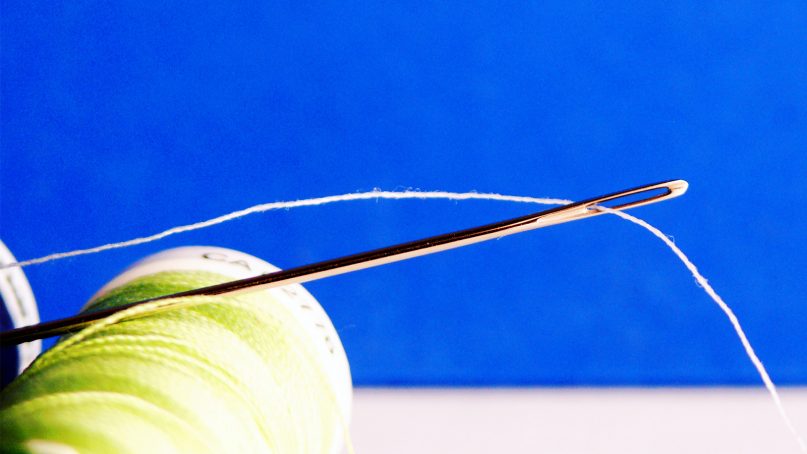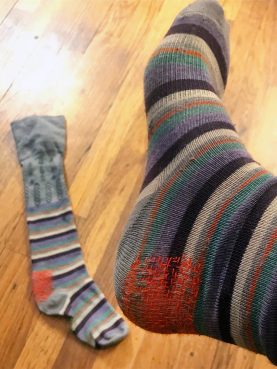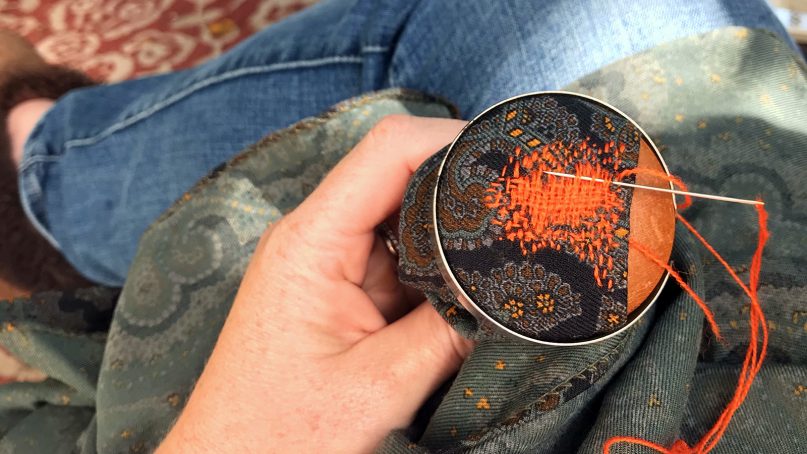(RNS) — There is not much reason to mend a worn sock. Socks are cheap. Overnight delivery can get me a new pair by the time I wake up tomorrow. Darning a sock takes time. And yet, I’ve made the commitment to slow down, stitch more and teach others as I take up mending as a spiritual practice.
In practice, most Americans know very little now about mending. I have set out to learn with my hands what I longed for in my life: to repair what is torn.
It seems I’m not alone. I’ve turned to mending, in part, because so much in all of our lives feels as if it is fraying and ripping apart. We talk about “mending the social fabric of our nation,” “tears in community” and “repairing the social safety nets.”
So stitch by stitch, I’m learning to repair. My teachers are YouTube videos, vintage pamphlets and octogenarian church ladies. Mostly, I’ve learned mending by sitting down and silently stitching. Mending is repeated practice that connects me to so many repairers.
Generations of young women before me learned mending as a domestic necessity, demonstrated in “mending samplers.” These samplers show mending so skilled that the repairs would appear invisible. The goal was an unnoticeable fix.

Sewing needle and threads. Photo courtesy of Creative Commons
In the early and mid-20th century, the U.S. Department of Agriculture issued mending pamphlets. During some of our history, mending was patriotic; now, purchasing is.
For most people today, however, mending is a choice. Tom Van Deijnen, a mender known as Tom of Holland, speaks wisely about why we mend now. The World War II “Make Do and Mend” campaign by the British government was born out of hardship and scarcity. In an interview with Sew Irregular, Tom says, “I don’t ‘make do’ and mend, instead I choose to mend.”
Mending is reorienting. Our ideas about innovation come these days primarily from the tech sector and those privileged few with venture capital. Mending re-centers poor people, women and people of color as innovators, design-thinkers and problem-solvers.
Mending is an environmental commitment. Amid the Marie Kondo-inspired frenzy to declutter, we fool ourselves if we think that our trashed textiles are gone once we discard them. The Environmental Protection Agency found exponential growth in our generation and trashing of textiles. In 1960, Americans turned 1,760,000 tons of textiles into municipal waste. By the most recent measure in 2015, we generated over nine times as much, or 16,030,000 tons as municipal waste. We are drowning in disposables. Mending asks us to fix what we have.
Mending, in fact, is trending. Between new books, museum exhibits and “mending cafes,” mending is having a moment. Unlike earlier eras, modern mending is not trying to make the repair invisible but instead embraces the beauty of #VisibleMending with contrasting colors or patterns. “Visible mending” gives me a language and image for honest repair, instead of pretending that all is well.
Mending is resistance. The global textile markets have changed our clothing consumption with cheap and “fast fashion.” Some estimate our wardrobes are 400% larger than they were 20 years ago. By mending, I aim to resist the disposability of the people and things. Mending honors the maker.

Sock darning. Photo by Laura Everett
Most of all, mending is spiritual practice. Before any stitch is sewn or any patch prepared, I have to ask myself, “Is this thing in my hands worth repairing?” When I answer “yes,” mending is an act of devotion.
As I’ve begun teaching mending, religious and nonreligious people alike have flocked to my “Mending Church” workshops. The metaphors are rich and tactile. We learn to look for the places that need repair. We discover holes at the elbows and fraying at the cuffs. We see stress at the seams. We notice the places of friction and instability often need the most repairs.
Sometimes we find that the garment was not well created to begin with and thus, prone to tearing. We learn to look carefully, and ask, “Is this worth fixing?” I find myself asking this often about my neighborhood, my city, my church and my country.
The more I’ve sat in silence darning an old sock, the more I’ve come to sense that this is what God is like. God is a mender. God takes what the world considers disposable, curls up in a large chair and looks with patience to repair what is broken in each of us. God sees our tears and tenderly stitches us up. Sometimes that repair feels like an unraveling. Yet, mending is an affirmation of worth.
Mending is practice for what my Jewish friends name as “tikkun olam” or “repair of the world.” We have the choice to destroy or to become co-participants in repair. I choose repair.
And for those who try to pattern our lives like Jesus, the story of Easter is a kind of repair.
In a Jerusalem, under the strain of Roman occupation, the fatal violence of the crucifixion has torn apart Jesus’ community. Jesus is raised from death yet still bears the marks of violence. Resurrection with scars is God’s act of “visible mending.” We who repair participate in God’s mending, too.
(The Rev. Laura Everett is a United Church of Christ pastor in Boston and is executive director of the Massachusetts Council of Churches. She is the author of “Holy Spokes: The Search for Urban Spirituality on Two Wheels.” Follow her on Twitter @reveverett. The views expressed in this commentary do not necessarily represent those of Religion News Service.)





